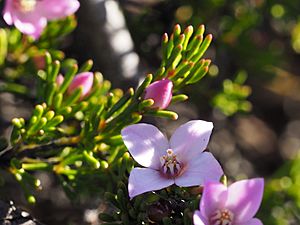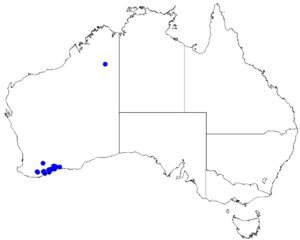Boronia oxyantha facts for kids
Quick facts for kids Boronia oxyantha |
|
|---|---|
 |
|
| Boronia oxyantha near Ravensthorpe | |
| Scientific classification | |
 |
|
| Occurrence data from Australasian Virtual Herbarium |
Boronia oxyantha is a pretty plant that belongs to the citrus family, called Rutaceae. It only grows in a small part of Western Australia, in the south-west. This plant is a shrub with lots of fuzzy branches. It has special leaves called pinnate leaves and beautiful pink flowers. Each flower has four petals with a darker line down the middle.
What it Looks Like
Boronia oxyantha is a shrub that has many hairy branches. It usually grows to be about 60 centimeters (24 inches) tall. Its leaves are compound, meaning they are made of several smaller parts. These leaves are often grouped closely together.
Each leaf has between three and seven small leaflets. These leaflets are narrow and shaped like a club, about 3 to 7 millimeters (0.1 to 0.3 inches) long. They sit on a tiny stalk called a petiole, which is only about 0.5 to 2 millimeters long.
The flowers grow one by one where the leaves meet the stem. They are on a small stalk called a pedicel, which is about 2 millimeters (0.08 inches) long. Each flower has four narrow, triangular sepals, which are like small leaves that protect the bud. These sepals are about 2 to 3.5 millimeters long and do not have hairs.
The four petals are broadly oval-shaped and pink. They have a darker line running down the middle. These petals are about 7 millimeters (0.3 inches) long and have a few soft hairs on them. Inside the flower, there are ten stamens, which are the parts that produce pollen. They have a few soft hairs and a noticeable bump at their tip. The stigma, which receives the pollen, is very tiny. This plant usually flowers from August to December, or sometimes until February.
Naming the Plant
The plant Boronia oxyantha was first officially described in 1852. This description was made by a scientist named Nikolai Turczaninow. He published his findings in a science journal called Bulletin de la Société Impériale des Naturalistes de Moscou.
The second part of its name, oxyantha, comes from two ancient Greek words. "Oxys" (ὀξύς) means "sharp," and "anthos" (ἄνθος) means "flower." So, the name hints at a feature of its flowers.
Where it Grows
This type of boronia plant grows in a specific area of Western Australia. You can find it on rocky slopes and elevated areas. It grows between the towns of Ongerup and Hopetoun. This region is known as the Mallee biogeographic region.
Conservation Status
The Western Australian Government's Department of Parks and Wildlife keeps track of plants. They have classified Boronia oxyantha as "not threatened." This means it is not currently at risk of disappearing.
Images for kids


